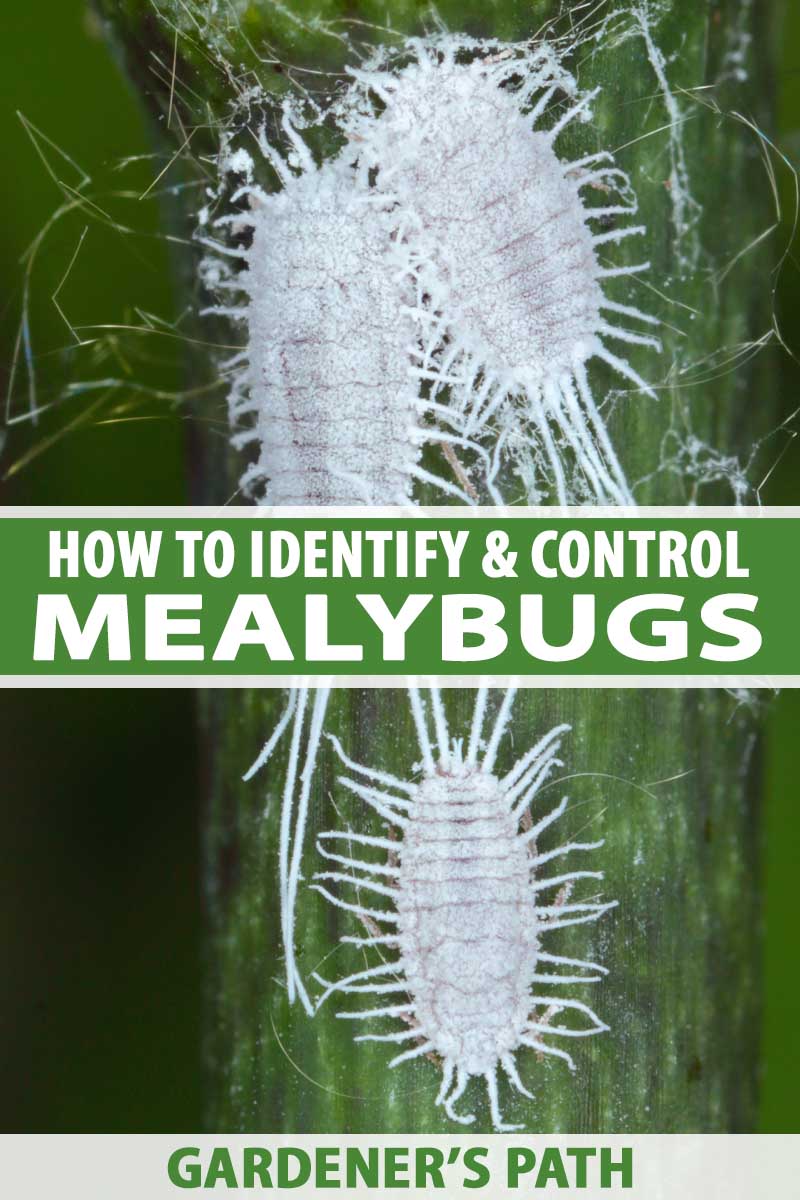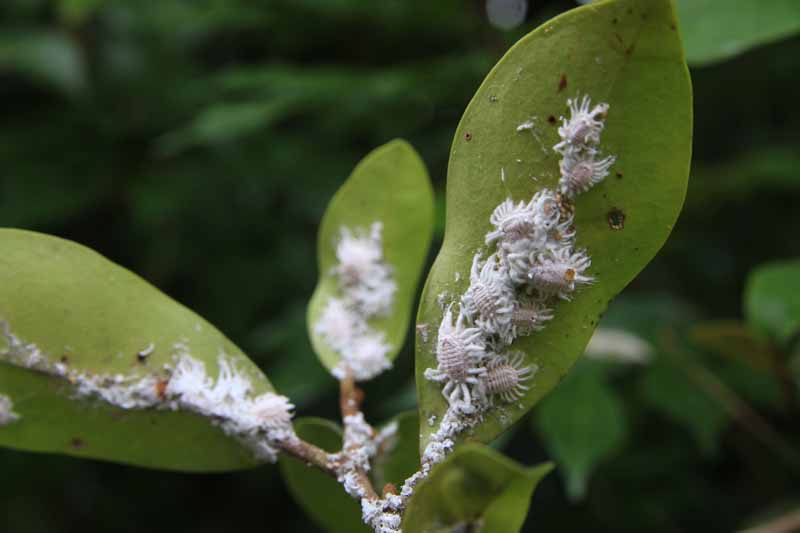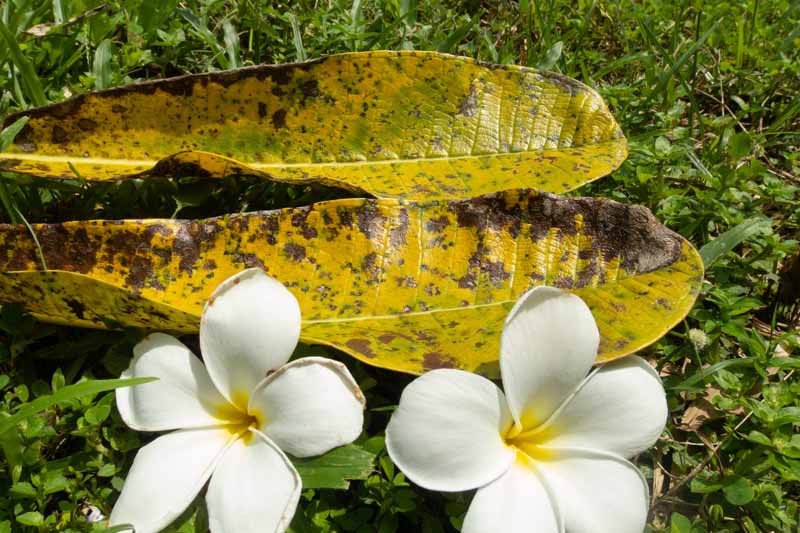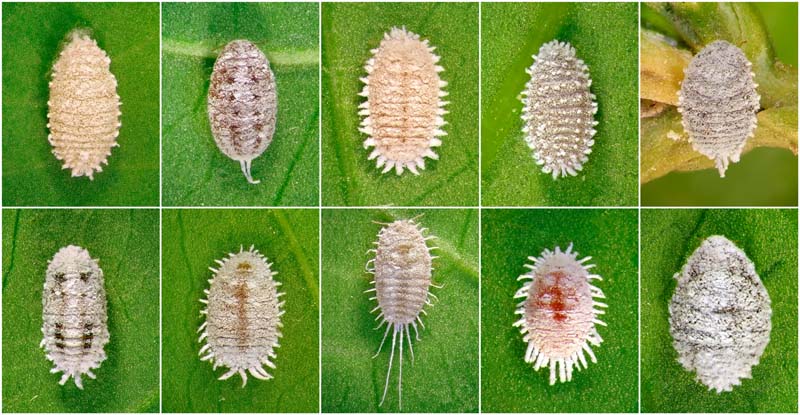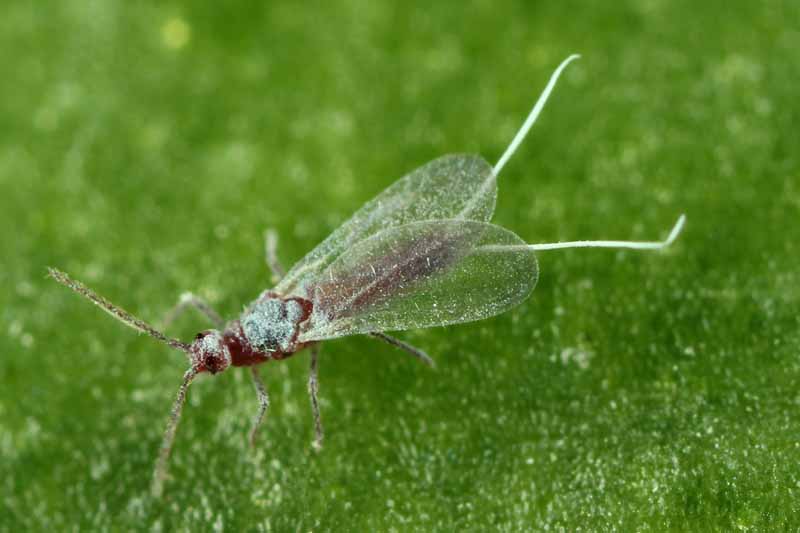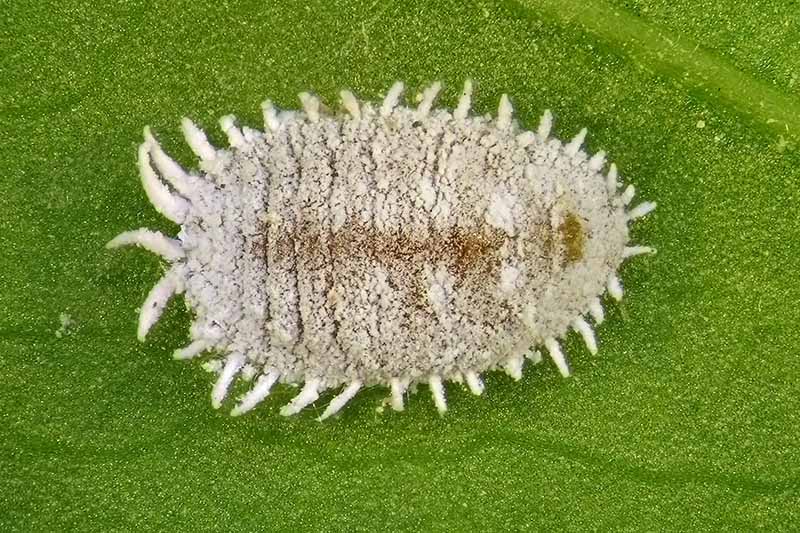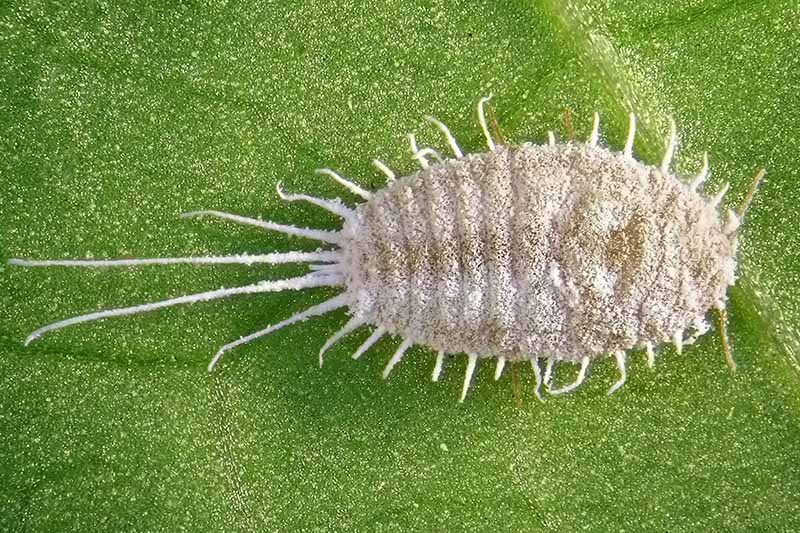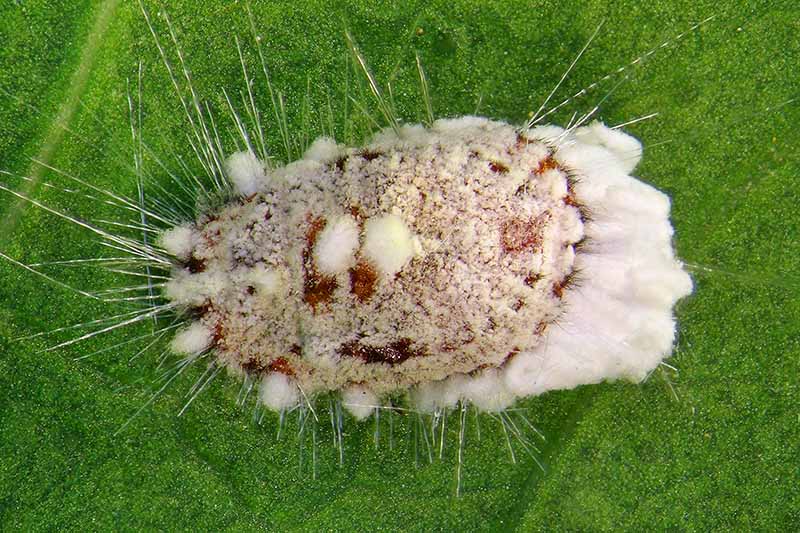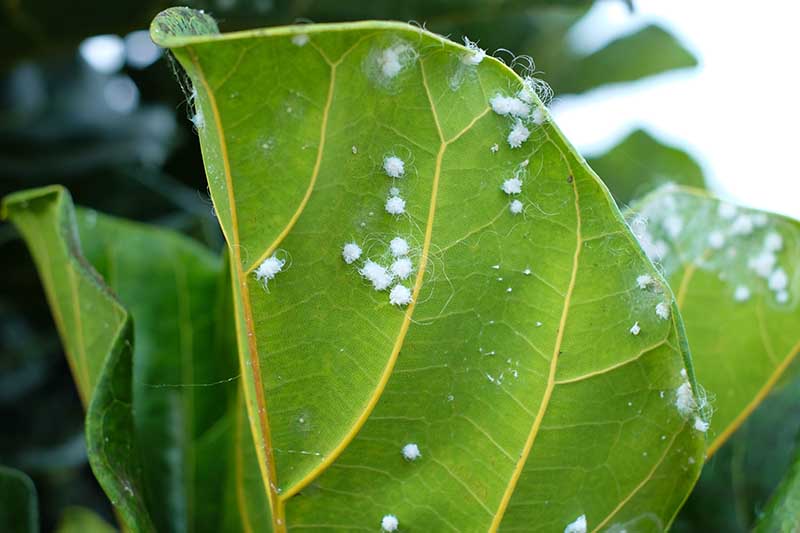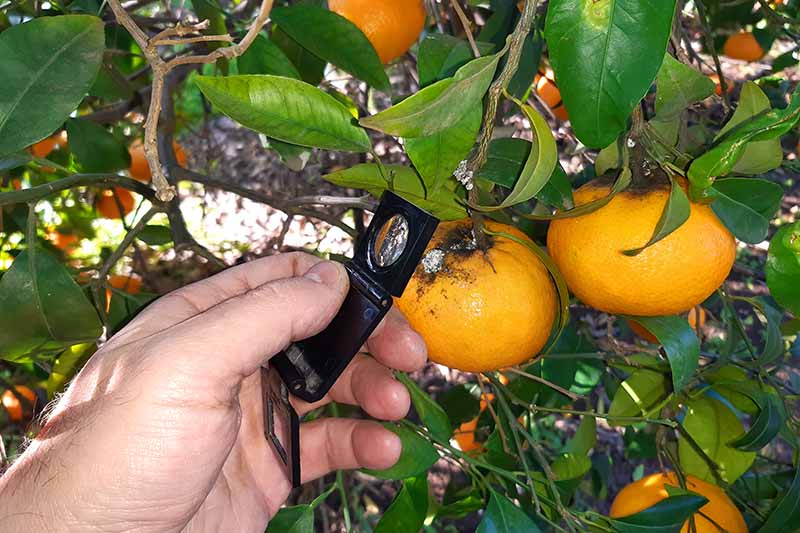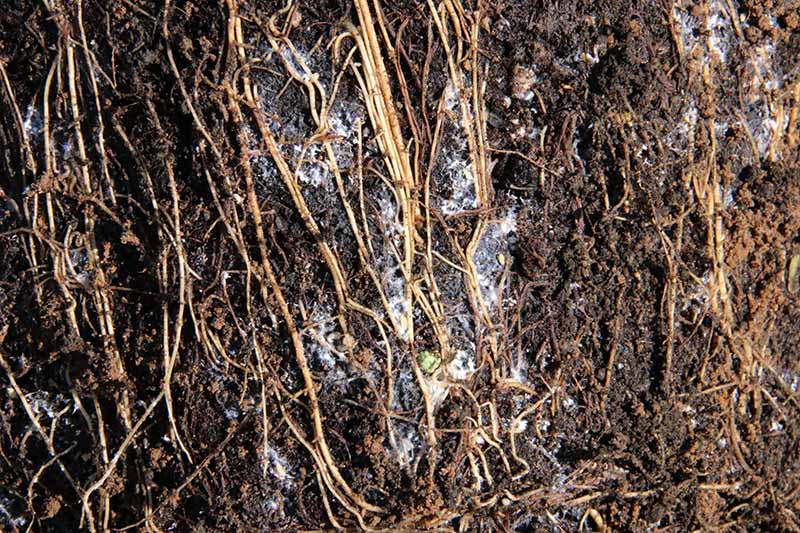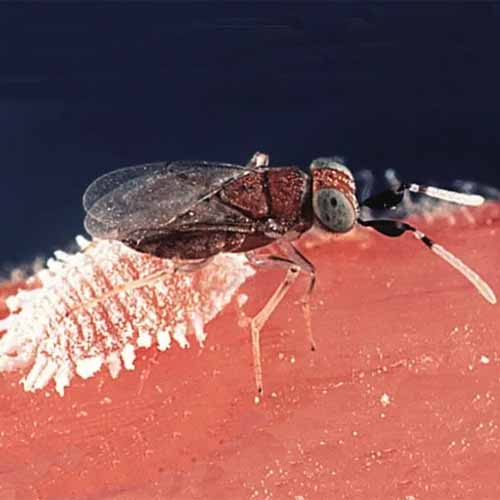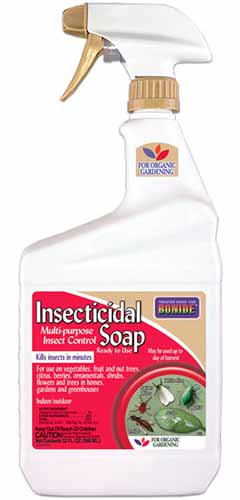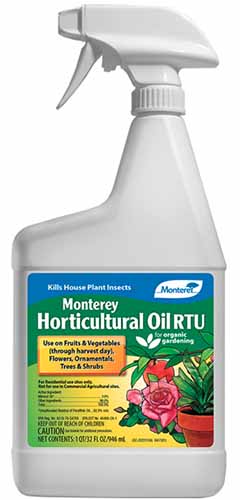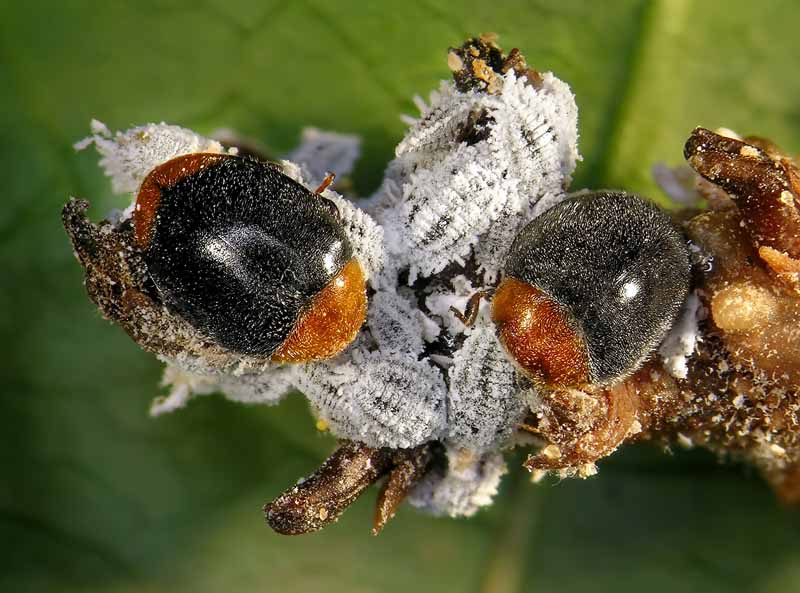When a sudden infestation of mealybugs occurred on my mom’s houseplants, though, everyone knew where to put the blame: on the cuttings I’d brought home from my university’s tropical greenhouse. We link to vendors to help you find relevant products. If you buy from one of our links, we may earn a commission. Luckily, there are options available to help you decrease their numbers and minimize the success of their invasion, and we’ve got it all laid out for you below! Here’s what we’ll talk about:
What Are Mealybugs?
Mealybugs are insects of the Pseudococcidae family, and there are about 275 species that inhabit the United States. They share their superfamily, Coccoidea, with soft scales. Many of the common species are in the Pseudococcus and Planococcus genera, including Planococcus citri, the citrus or greenhouse mealybug, and Pseudococcus longispinus, the long-tailed mealybug. Pseudococcidae species love to congregate in protected areas between plant parts, such as crevices, narrow spaces between touching fruits and leaves, on stems near the soil, and in the case of root feeding species, nestled between the roots and the soil. These insects will feed on most ornamental species, including woody and herbaceous perennials, flowers, trees (especially citrus trees), grapes, orchids, succulents and cacti, and even some grasses. They are common in greenhouses and indoor spaces, as they love warm, moist climates. These insects suck plant juices straight from the phloem with their piercing-sucking mouthparts, which are basically like sharp straws. The phloem is the part of the vascular system that transports the sugary products of photosynthesis (photosynthates) around the plant. Therefore, you can often find them clustered on leaf veins and midribs, happily slurping up the plant’s hard-earned food. Like aphids, they secrete a sticky, sweet liquid known as honeydew from their abdomens. Black sooty mold grows on these excretions, which makes a plant look quite ugly. Learn how to deal with sooty mold here. Ants love the honeydew treats so much they’ll protect the mealybugs from natural enemies, and even carry them to fresh plants. Not only are plants infested with mealybugs, covered in sooty mold, and crawling with ants quite unsightly, but they will also have reduced vigor. If flowers are attacked, there may be poor fruit set. And fruits covered in feeding, fuzzy insects and black mold are not only unappetizing, but the fruits may drop or shrivel on the tree as well. While feeding, Pseudococcidae pests can serve as a vector for viruses that can cause yellowing and necrosis (death). Grapevine leafroll virus, for example, is vectored by both the long tailed and citrus mealybugs. It causes leaves to turn red or yellow, thick, and brittle, and eventually they roll up.
Identification
As a family, you can think of mealybugs as small, generally one centimeter long, oval shaped, white to gray, segmented, wax covered, wingless insects. Often helping with identification between species, some grow filaments that look like long white legs down the sides of their bodies, or that resemble two to three waxy tails on the end of their abdomens, while others don’t grow filaments at all. This description covers older nymphs and adult females from many species, though there are a variety of color shades. Male adults look like gnats, with two wings and four eyes. Nymphs of both sexes are flat and come in pale shades of yellow, orange, or pink. The early instars don’t have a waxy covering. Pink to yellow eggs are laid in white or cream cottony wax-covered sacs known as ovisacs. P. citri, the citrus mealybug, is the most widespread and damaging greenhouse species. These have a gray stripe down the length of their bodies and don’t grow long filaments. When they feed, they inject toxins which deform the plant. P. longispinus, the long-tailed mealybug, grows long filaments from the end of its body, and instead of laying eggs like most species do, gives birth to live young. Rhizoecus species are root feeders. These have sac-shaped bodies, produce live young, and grow a long filament from the end of their abdomens. It’s easy to confuse them with cottony cushion scales (Icerya purchasi) or woolly aphids (subfamily Erosomatinae). Cottony cushion scale females have a red-brown body color and a plume of white fluff extending from their bodies. Aphids, including woolly aphids, tend to be more active, and will sometimes have wings, feed on leaf undersides and on stems, and are not as worried in general about finding a crevice to hide in. If you see something on your plant that looks like a fungal or mildew infection, take a closer look to make sure it’s not a Pseudococcidae infestation, as the two can look quite similar!
Biology and Life Cycle
The life cycle varies by species, but in general, females will lay up to 600 eggs in ovisacs in protected areas on plant crowns, leaves, bark, or fruit. Alternatively, some species give birth to live young, as mentioned above. Eggs take six to 14 days to hatch, emerging as tiny nymphs. For most species, the females go through four instars, which are the stages between each time they molt as the insect develops. Males have five instars. During the nymph stage, they are known as crawlers and are very mobile. Adults have legs as well but tend to be slow moving. They don’t typically move far, and prefer to settle in one spot to feed. Early on in their lives as crawlers, nymphs lack that protective waxy covering, and this is the best time to implement organic and chemical pesticide control methods. Once they mature into adults, the waxy coating repels moisture – as well as any chemicals that may be carried along with it. Males are rarely seen, as they are tiny, only live for a few days, and don’t feed. They aren’t always even needed, as many species have females that can reproduce asexually. This is known as parthenogenesis, where the embryos develop without fertilization. Depending on the species, they can complete two to six generations per year. Those braving the great outdoors usually finish two and will overwinter as eggs or early instars under bark. Indoors, and outdoors in warm climates, you’ll be able to find all stages at one time.
Monitoring
As they are small and love to hide in protected places, it’s easy to miss a few mealybugs that are sucking on your plant. That is, until they’ve completely taken over. Regularly check all crevices as well as leaf and flower whorls, examining for egg masses, nymph or adult aggregations, or individual crawlers. Use a hand lens to help you see the difference between these bugs or other insects and fungal infections. Check any outdoor plants before bringing them inside for the winter. Favorite hosts include many of the various soft and juicy plants that we like to spruce up our homes with, such as orchids, and various types of cacti and succulents. Certain outdoor ornamentals and fruiting plants are commonly affected as well, such as hibiscus, citrus trees, and grapes. If you notice yellow or wilted foliage, check the roots for underground infestation by removing the pot and gently knocking soil away from a section of root if the roots aren’t visible.
Organic Control Methods
These insects are notoriously hard to control. They hide in protected areas, grow a waxy coating which shields them and repels chemicals, spread easily on new plants as well as tools and pots, and can survive without feeding on live material for up to two weeks. Luckily, there are a variety of options for homeowners, including some efficient and hungry natural volunteers. Using an integrated pest management (IPM) approach is your best option, as this will optimize and protect the natural enemies of these pests while providing effective control. You can find out more about IPM and how to design a good program for your garden here.
Biological Control
There are many natural enemies in the landscape that like to make a meal out of mealybugs. Outdoors, and when introduced into greenhouses, these beneficials can keep populations at tolerable levels. Parasitic wasps, ladybugs, green and brown lacewings, spiders, minute pirate bugs, and predaceous midge larvae can launch an impressive assault on Pseudococcidae species.
Cultural Control
Since the females can’t fly and don’t move quickly when they do decide to use their short legs, these insects don’t rapidly disperse on their own. You can purchase these predators at Arbico Organics and introduce them to your greenhouse! Leptomastix dactylopii are small amber colored wasps which parasitize older instar nymphs or adults by laying their eggs in the bodies of these pests. The resulting larvae eat the host’s body from the inside out, turning it into a hard yellow mummy. P. longispinus is targeted by none other than the long-tailed mealybug parasitoid, Anagyrus fusciventris. Anagyrus fusciventris This tiny wasp not only parasitizes pests in the older life stages, but the adult wasps also puncture and feed on those in the young stages. You can find these predators available at Arbico Organics. If they spread, it’s probably the fault of the plant owner. (Or in my mom’s case, a well-meaning daughter bearing cutting gifts…) So, it makes sense that the best way to protect your plant babies is to carefully inspect any new introductions before you bring them home. Check your tools and pots too, especially under rims and in grooves. Clean up debris and remove any loose bits of bark, as these make good overwintering sites. Destroy heavily infested plants. Avoid unnecessary fertilizer applications, as excess nitrogen can cause plants to grow too quickly, resulting in weak, soft growth that is more susceptible to damaging insects. Plus, it can cause an increase in mealybug egg production as well.
Physical Control
If you have the time and good eyes, you can handpick mealybugs off your plants to physically remove aggregations or individuals, especially if there aren’t many yet. Alternatively, spray plants with a hard jet of water to dislodge egg sacs, crawlers, and adults.
Organic Pesticides
You may need to resort to using spot treatments if there are no natural enemies present in your greenhouse or home. Use a cotton swab soaked in isopropyl alcohol to kill aggregations and egg masses. Allow these products to dry on the plants and start taking effect before releasing beneficials. Be aware that neem oil can be toxic for pollinators such as bees, so use early in the morning or later at night when they aren’t present. With several applications and good coverage, insecticidal soaps can be effective against those in the crawler stage. Bonide Insecticidal Soap Find insecticidal soap products such as Bonide Insecticidal Soap at Arbico Organics, or Garden Safe Insecticidal Soap at Home Depot. Monterey Horticultural Oil Apply horticultural oil, such as this product from Monterey, available from Arbico Organics, or neem oil to knock down pest populations before introducing a beneficial insect species like Cryptolaemus montrouzieri or lacewings. But keep in mind that pyrethroids can harm beneficial insects, so scout for the presence of natural enemies before using, and use with caution! Indoor Outdoor Insecticide with Bifenthrin Systemic insecticides are more effective than contact insecticides, as they course through the plant itself and will be sucked up by any insects that are feeding on it. Be sure to follow all package instructions for safe use if you choose to apply these products. Neonicotinoids such as imidacloprid and dinotefuran are sometimes used by commercial growers to control outbreaks, since they don’t require multiple applications. And, being systemic, reach places on the plant that contact insecticides wouldn’t.
Pestered Plants
Whether you realize you’ve got them or not, mealybugs are not welcomed by plant owners or plants. These tiny, soft, alien looking insects suck sugary life blood, excrete sticky honeydew which grows ugly sooty mold, and can vector disease. Someday, when I’m sure my mom’s forgotten who introduced mealybugs to her plant collection in the first place, I’ll carefully approach the subject of how she treated them. Until then, have you ever dealt with a mealybug infestation? Tell us about where you believe it originated and what strategies you had success with in the comments section below! And while you’re at it, learn how to protect your garden and houseplants from other sucking insects beginning with these articles on common garden pests next:
Managing the Aphid: An Unwelcome Garden VisitorHow to Manage a Spotted Lanternfly InfestationHow to Identify and Control Earwigs in the GardenHow to Identify and Control Scale Insects in the Garden
